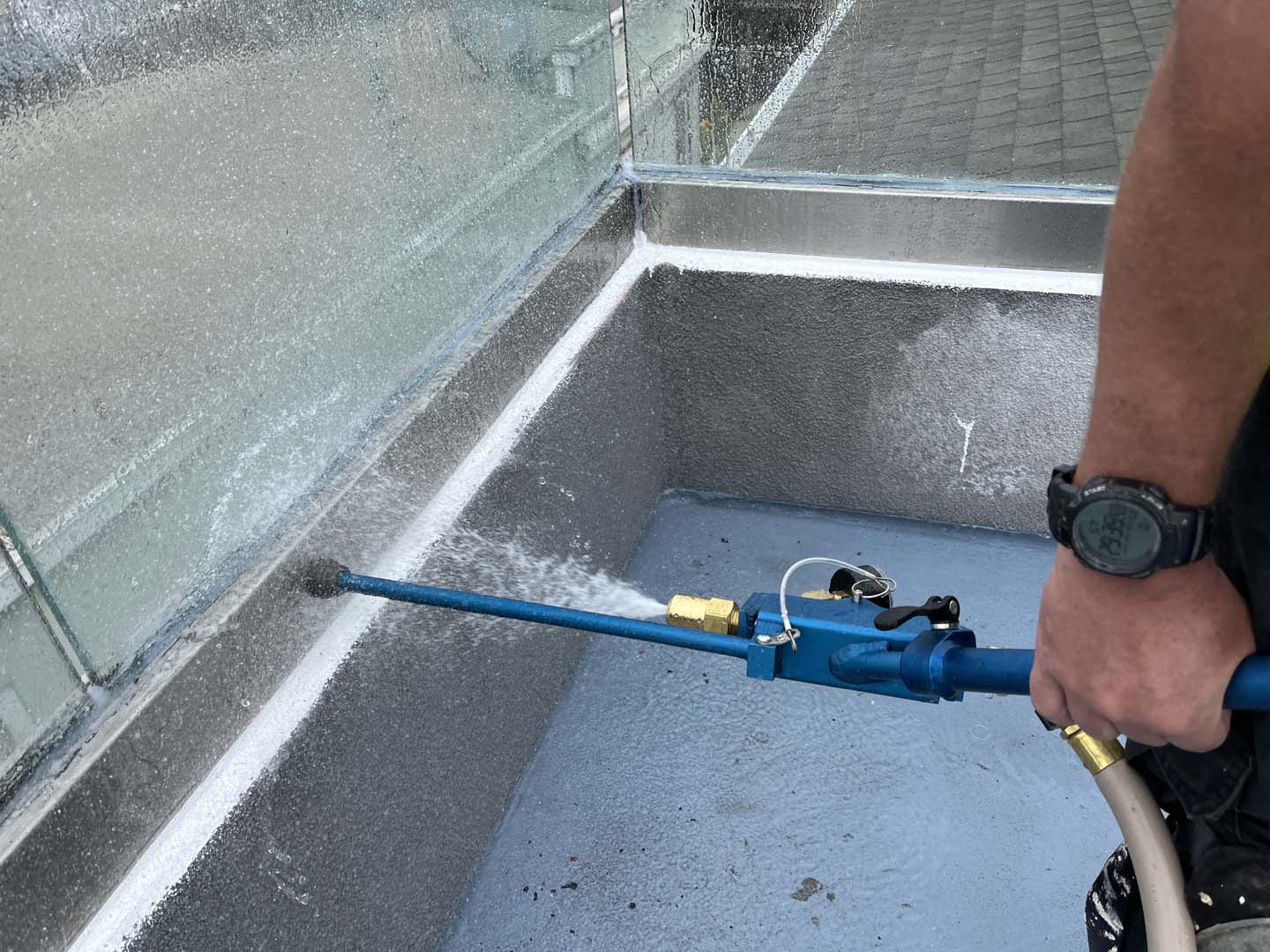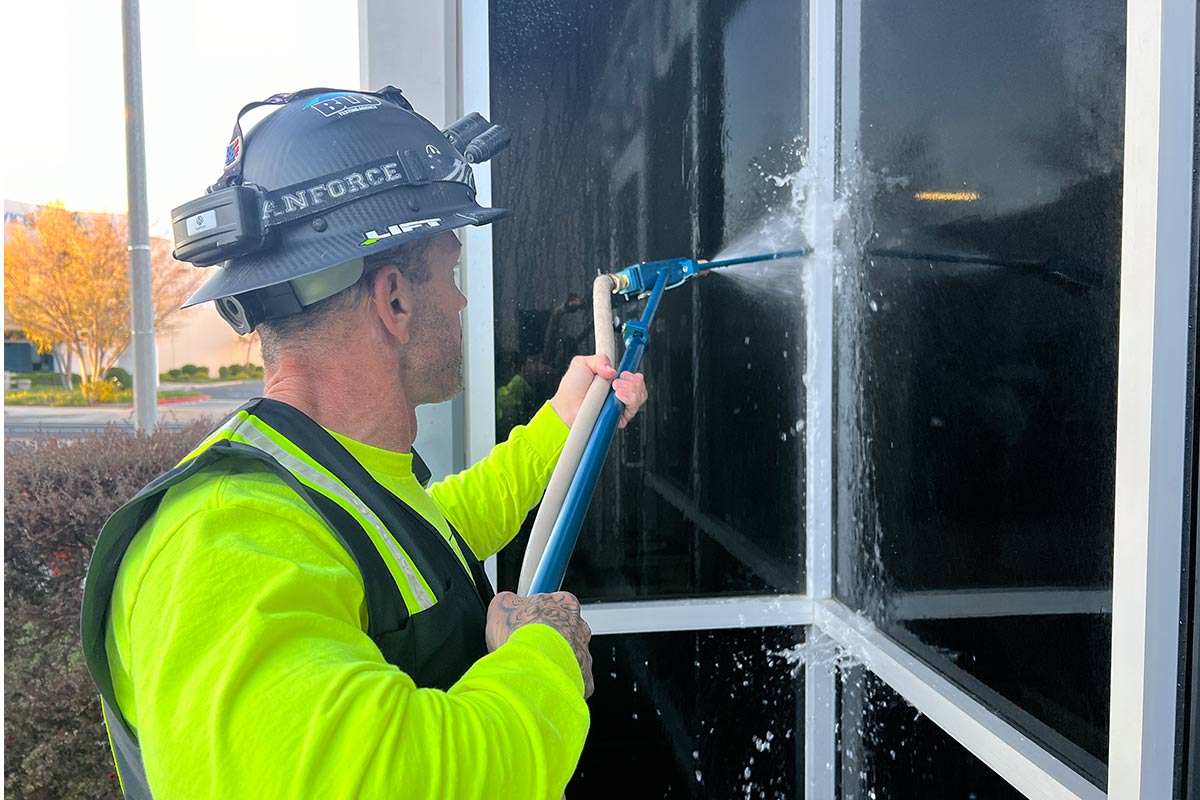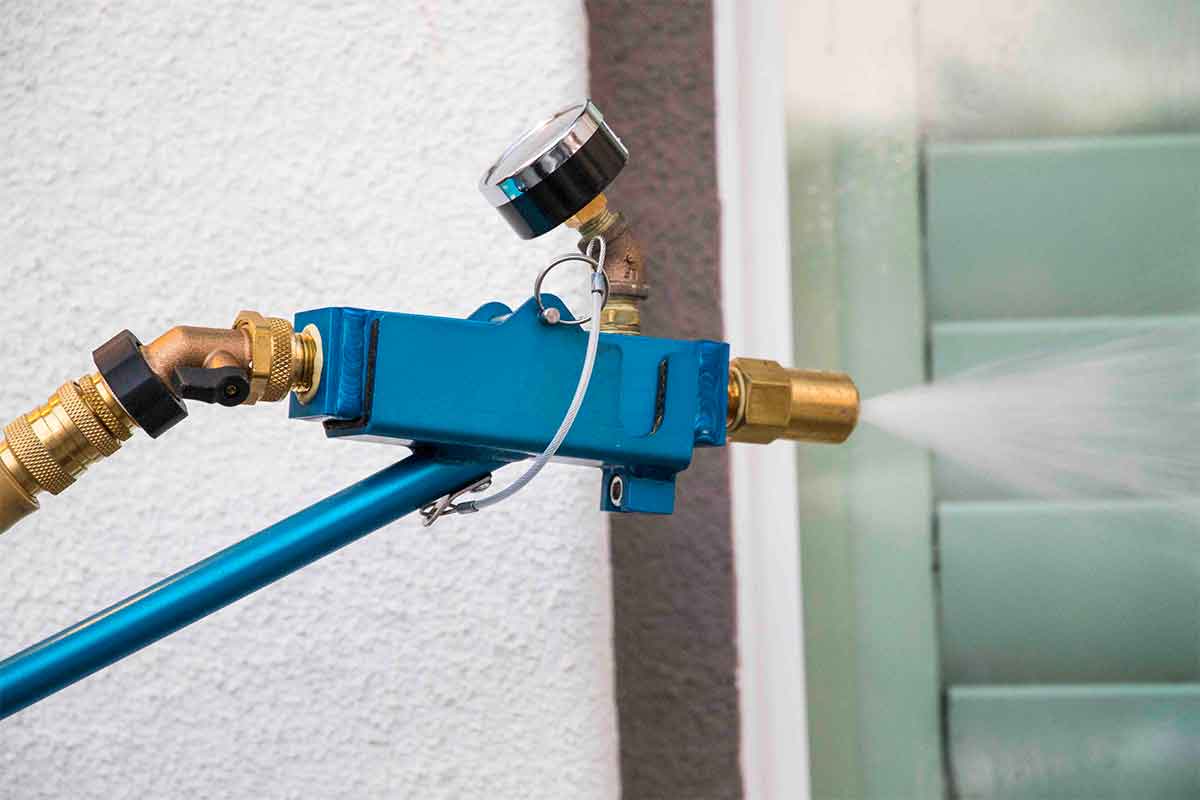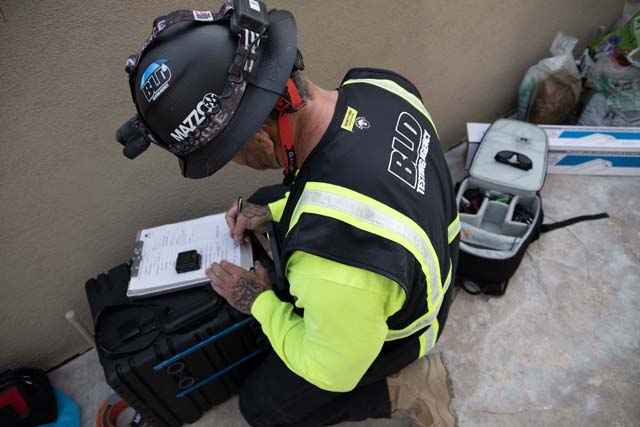The AAMA 501.2 test is a Quality Assurance and Diagnostic Water Leakage Field Check of Installed Storefronts, Curtain Walls, and Sloped Glazing Systems
The AAMA 501.2 quality assurance and diagnostic water leakage field test is used as a standardized test procedure. This evaluation is designed to test the performance of installed storefronts, curtain walls and sloped glazing systems. This means that the Building Leak Detection specialists check the joints, gaskets and sealant details also known as perimeter caulking in the windows. These window systems are intended to remain permanently closed and should be water tight.

The AAMA 501.2 Uses a Spray Wand to Test the Installed Storefronts, Curtain walls and Sloped Glazing
A very specific nozzle manufactured by Monarch must be used for this standardized test. The nozzle should be attached to a spray wand or other apparatus. A calibrated pressure gauge must also be connected to the system. The pressure for this field test should be 30 to 35 PSI. There are certain exceptions in which the water pressure can be lower, for instance, a historical building.
The Testing Procedure
There are very specific procedures to give this water test. Building Leak Detection Company is very familiar with this type of testing which is normally for commercial buildings. First of all, the area needs to be divided into 5 foot sections. Each of these sections should be sprayed continuously for 5 minutes with the nozzle by moving it slowly back and forth. The nozzle needs to be held perpendicular to the testing section. All sections will be tested using this process.
While the water intrusion professional is performing this test on the outside, on the inside, there is someone observing for any leaks or water penetration. Any leaks should be noted and suggestions for remediation will be given.
The Reporting Process for the Water Leakage Testing Results of the AAMA 501.2
The Building Leak Detection Company will provide a written report for the clients. They will report the material, manufacturer of the windows and their location on the building. The condition of the test specimen and any modifications should also be noted.
The testing procedure will be explained as well as the testing results including any testing points of water leakage. There will also be a statement that assures the compliance of the testing to the AAMA 501.2 standard.

AAMA testing Standards and what you need to know
The American Architectural Manufacturers Association (AAMA) sets standards that are vital to the construction industry, particularly when it comes to fenestration products. The AAMA 501 series addresses the performance of curtain walls and storefronts concerning water penetration and structural integrity. These standards are meticulously developed to ensure that buildings can withstand environmental stresses while maintaining their aesthetic appeal and functional performance. By adhering to these standards, builders and manufacturers can assure clients of the quality and durability of their products, fostering trust and reliability within the industry.
AAMA 501.2 is a specific standard within the AAMA 501 series
AAMA 501.2 is a specific standard within the AAMA 501 series. It focuses on quality assurance and diagnostic field testing for water leakage. The test is designed to simulate wind-driven rain conditions to assess whether installed curtain walls and other glazing systems can withstand water infiltration under realistic conditions. This simulation is crucial as it replicates the kind of severe weather conditions that buildings might face throughout their lifespan, providing a robust measure of their water resistance capabilities. Moreover, by identifying any vulnerabilities early on, AAMA 501.2 allows for timely interventions that can prevent more significant issues from developing over time.
How this specific AAMA 501.2 test is important, is because it helps identify potential weaknesses in the building envelope before they become major problems. By conducting this test, builders and owners can ensure that their structures are protected against water damage, thus avoiding costly repairs and health hazards associated with mold and mildew. Water damage, if left unchecked, can compromise the structural integrity of a building, leading to extensive and expensive repairs. Furthermore, mold and mildew growth can create unhealthy indoor environments, posing risks to occupants’ health and wellbeing. Implementing the AAMA 501.2 test as part of the construction and maintenance process is a proactive measure that safeguards both the building and its inhabitants.

Applying the AAMA 501.2 test
Applying this AAMA 501.2 test involves several steps and requires specialized equipment. Here’s a breakdown of how the test is typically conducted. Understanding these steps is crucial for those involved in the construction and maintenance of buildings, as proper execution of the test ensures accurate and reliable results. Each step is designed to rigorously evaluate the water resistance of the building envelope, providing valuable insights into any areas that may require attention or improvement.
To perform the AAMA 501.2 test, a water spray rack and a calibrated spray nozzle are used. The spray rack is designed to deliver a uniform spray pattern over the test area, simulating the effect of wind-driven rain. This equipment must be carefully calibrated to ensure that the test conditions accurately mimic real-world scenarios, allowing for a reliable assessment of the building’s water penetration resistance. The precision of this equipment is vital, as any discrepancies in the spray pattern or water pressure could lead to inaccurate results, potentially overlooking critical vulnerabilities in the building envelope.
- Preparation: Before starting the test, the area to be tested must be thoroughly inspected and cleaned. All operable parts of the curtain wall should be closed and locked. This step ensures that the test area is in optimal condition, free from debris or obstructions that could skew the results. Proper preparation sets the stage for a successful and accurate assessment.
- Calibration: The spray nozzle is calibrated to ensure it delivers water at the correct pressure and flow rate. This step is crucial for obtaining accurate results. Calibration must be performed with precision, as any variance can affect the reliability of the test outcomes. Ensuring the nozzle is calibrated correctly guarantees that the test conditions are consistent with AAMA standards.
- Testing: The spray rack is positioned at a specified distance from the test area. Water is sprayed at the rate of 5 gallons per hour per square foot for a duration of 15 minutes. This simulates heavy rain conditions driven by wind. The test’s rigorous conditions are designed to challenge the building’s water resistance capabilities, providing a comprehensive evaluation of its performance under duress.
- Observation: During the test, inspectors check for any signs of water leakage on the interior side of the curtain wall. Any leaks are noted and addressed. Observing the test area closely allows inspectors to identify even the smallest breaches in the building envelope, ensuring that all potential issues are documented and rectified.
- Reporting: After the test, a detailed report is compiled, documenting the test conditions, observations, and any corrective actions taken. This report serves as an essential record, providing valuable insights into the building’s water resistance performance and guiding any necessary remedial work. Comprehensive reporting ensures transparency and accountability, facilitating informed decision-making for future maintenance and improvements.

What can you leak from performing this test?
The results of the AAMA 501.2 test can reveal whether the building envelope meets the necessary standards for water resistance. If leaks are detected, it indicates that repairs or improvements are needed to prevent future water intrusion. Interpreting these results requires a keen understanding of the test parameters and the specific vulnerabilities of the building envelope. By accurately diagnosing any issues, stakeholders can implement targeted interventions that enhance the building’s performance and longevity.
The AAMA 501.2 test offers several benefits for builders, property owners, and occupants. By proactively addressing water penetration issues, this test contributes to the overall integrity and sustainability of a building. The benefits extend beyond immediate cost savings, impacting long-term structural health and occupant wellbeing.
By identifying potential water leakage points, the test helps ensure the structural integrity of the building. This can prevent costly damage and extend the lifespan of the structure. Structural integrity is paramount for any building, as it directly impacts safety and functionality. By maintaining a watertight envelope, buildings are better equipped to withstand environmental stresses, preserving their structural soundness over time.
Water intrusion can lead to mold growth, which poses serious health risks to building occupants
Water intrusion can lead to mold growth, which poses serious health risks to building occupants. The AAMA 501.2 test helps prevent these issues by ensuring that the building envelope is watertight. A healthy indoor environment is crucial for occupant wellbeing, and preventing mold growth is a key component of this. By ensuring that water cannot penetrate the building envelope, the test protects against the health hazards associated with damp and moldy conditions.
Detecting and addressing water leakage issues early can save property owners significant amounts of money in repairs and maintenance. It’s much cheaper to address minor leaks than to repair extensive water damage. Early intervention is always more cost-effective than addressing damage after it has occurred. By implementing the AAMA 501.2 test, property owners can avoid the substantial costs associated with major repairs and renovations, preserving their investment over the long term.
Meeting AAMA 501.2 standards is often a requirement for building codes and insurance. Passing the test provides peace of mind that the building complies with industry standards and is protected against water damage. Compliance with these standards not only ensures legal and insurance requirements are met but also instills confidence in the building’s performance and durability. Knowing that a building
